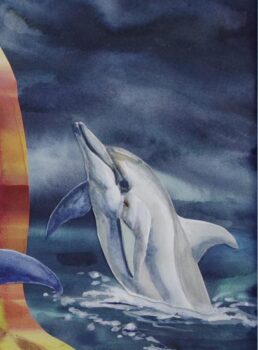The article excerpt below is from American Watercolor, and it’s for all my watercolor painting compatriots out there. I started out as an acrylic painter but grew to love watercolor as time went on. I learned techniques just like anyone else, and sometimes I use what I learned and sometimes I don’t. My goal has never been to paint like someone else, but I do love new and good ideas. What I never understood is people who say to me that “watercolor painting is so hard.”
Watercolor painting is the opposite of hard if you can relax and allow yourself permission to do what you want. There should be no (or very few) rules in watercolor painting, and there are no rules in actual painting techniques. We’ve all seen painting techniques that are wild and unique. But some people are stuck trying to “follow the rules”. If you belong to a watercolor painting group that insists you need to follow some arbitrary rules to exhibit with them, like not ever using opaque paint for example, in order to be meet their purist standards, you need to dump that watercolor group. Those rules are going to stifle your creativity.
The best advice on this is from artist Helen Frankenthaler.
“Helen Frankenthaler was an immeasurably influential American abstract artist known for, among other things, kick-starting Post-Painterly Abstraction. She championed individuality and experimentation. Through her innovative techniques and intellectual demeanor she pioneered methods of painting that defined not only her career, but also those of several of her contemporaries. Over the course of a professional career that spanned six decades Frankenthaler remained dedicated to openness and originality, demonstrating the value of her personal motto: “There are no rules. That is how art is born, how breakthroughs happen. Go against the rules or ignore the rules. That is what invention is about.”
It’s a huge burden on a painter’s psyche to worry about following rules when painting. My advice is be creative! Do what you want! (And join my online painting group instead, soon to be announced). Paint with no restrictions. You don’t have to accept other peoples’ arbitrary painting rules. For example, have you ever done this simple thing?

If there is some other reason watercolor painting is “hard” I’m not aware of it. I think people are referring to all the rules, or perhaps the non-existant need to plan ahead. You can plan ahead in your watercolor painting, or you can not plan at all. It’s totally and completely up to you. I know of some abstract watercolor painters who are the most spontaneous painters you can imagine, and others who plan as they paint and don’t follow any painting rules whatsoever. That is true painting freedom and with that freedom comes happiness. If you have to overplan your paintings you will be filled with stress and stress takes a lot of the creativity out of your artwork.
Paint with Abandon
“Good paintings teach a watercolorist very little,” says Iain Stewart. “It’s the bad paintings that instruct me how to improve my work because I have to look critically at them to identify the reasons they failed. [I personally feel that very few watercolor paintings are “bad”. I have seen some very “bad” – IMO -paintings win awards, as you probably have too.]
“Too many artists focus on creating masterpieces, and they are crushed when they are not successful. In my experience as a painter and teacher, our work is more successful when we risk failure, paint with abandon, and then evaluate the results.”
If you are an artist, remember that saying – “Dance like nobody’s watching” and paint like nobody’s watching! If you are an art collector, just have appreciation for creativity and expression. True art doesn’t need to live up to anyone’s expectations and it does not need to be judged or compared to other art, but just appreciated for what it is.
Below are some examples of my earlier watercolors. Most of these involved a great deal of planning, though Nickajack Creek and Tulum at Night are both in a looser style.
Contact us for international shipping costs before you buy.
All Art on FAS is copyright 2024, all rights reserved. No usage allowed. No exceptions.
Get updates on special events and news!